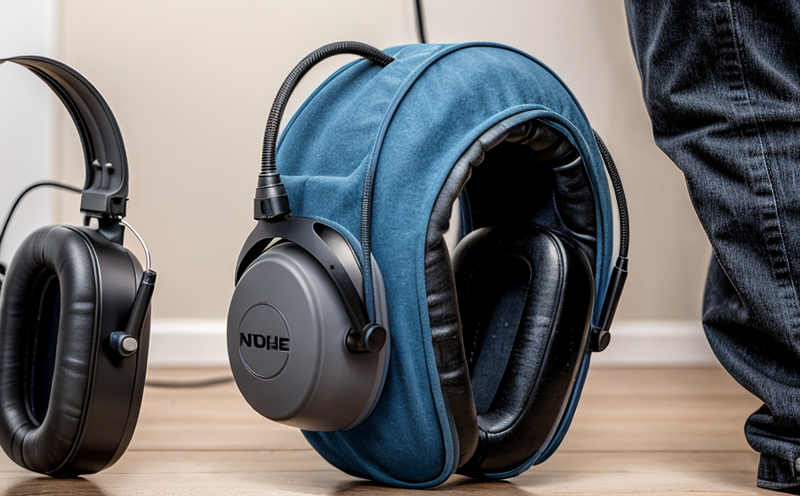EN ISO 4869-4 Real-Ear Attenuation Testing
The EN ISO 4869-4 standard for real-ear attenuation provides a robust framework to evaluate the effectiveness of hearing protection devices (HPDs). This method is critical in ensuring that occupational safety and protective equipment meet stringent noise control requirements, thereby safeguarding workers from potential hearing loss. The standard specifies procedures for measuring the real-ear attenuation provided by HPDs using a combination of audiometric coupler measurements and real-ear measurement techniques.
The procedure involves fitting an HPD on the subject, connecting it to a sound source, and then measuring the attenuation experienced by the ear canal. This is compared against theoretical calculations derived from coupler test results, which are specific to each model of hearing protection. The goal is to ensure that the actual attenuation provided matches the manufacturer’s claims within acceptable limits.
The testing process begins with careful selection and fitting of the HPD. Proper fit is crucial as even a small discrepancy can lead to significant deviations in measured attenuation. This step involves ensuring that the ear canal is properly sealed by the earmold or foam insert used in the HPD, which affects sound transmission.
Following this, the audiometric coupler method is employed where sound attenuators are placed into a standard audiometric coupler. The coupler simulates the human ear canal and provides a reference point for comparing the real-ear attenuation measured on the subject’s actual ear to that of the simulated ear in the coupler.
Real-ear measurements are conducted using an insert probe microphone, which is inserted into the subject's ear canal. This allows direct measurement of sound pressure levels at the eardrum plane while the HPD is worn. The difference between these real-ear attenuation values and those obtained from the coupler tests provides a measure of how well the HPD actually attenuates noise in practice.
Acceptance criteria for EN ISO 4869-4 are based on specific thresholds that define acceptable levels of attenuation across different frequencies. These standards ensure that workers receive adequate protection against hazardous noise environments, which is essential given the prevalence of occupational hearing loss worldwide.
The testing process is meticulously executed to meet these stringent requirements, ensuring accurate and reliable results. Compliance with this standard not only guarantees worker safety but also helps organizations comply with international regulations, enhancing their reputation for responsible corporate citizenship.
| Frequency Range | Attenuation Criteria |
|---|---|
| 20 Hz to 8 kHz | Average attenuation of the HPD at specific frequency bands must meet or exceed the specified ISO standards. |
The importance of this testing cannot be overstated, as it directly impacts worker health and safety. By adhering to these rigorous standards, organizations can ensure that their employees are protected from harmful noise levels in the workplace.
Benefits
Adopting EN ISO 4869-4 real-ear attenuation testing offers several key advantages for businesses operating in high-risk environments. Firstly, it enhances worker safety by ensuring that the hearing protection devices provided are effective and meet the necessary standards. This contributes to a safer work environment, reducing incidents of noise-induced hearing loss.
Secondly, compliance with this standard can lead to regulatory approval and certification, which is crucial for meeting legal requirements in many industries. Organizations operating internationally may face varying regulations; however, adhering to EN ISO 4869-4 ensures that they meet a globally recognized benchmark.
The testing process also supports continuous improvement in product design by providing detailed insights into the performance of different HPDs. This information can be used to refine and enhance future products, ensuring better protection for workers.
Moreover, adopting this standard demonstrates a commitment to safety and quality, which is highly valued by customers and stakeholders alike. It enhances brand reputation and builds trust with employees and the public.
Industry Applications
- Construction sites where heavy machinery operates continuously
- Mining operations where noise levels can be extremely high
- Agricultural environments, especially for workers operating large equipment
- Manufacturing facilities with noisy machinery and processes
- Aviation industry personnel exposed to loud engine noise during takeoffs and landings
The real-ear attenuation testing under EN ISO 4869-4 is particularly useful in these industries, where the risk of occupational hearing loss is high. By ensuring that the HPDs used effectively attenuate sound at critical frequencies, organizations can significantly reduce this risk.





